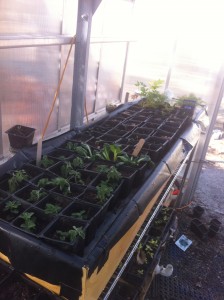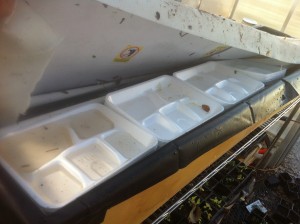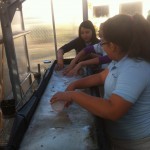


|
Commenced:
|
01/05/2010 |
|---|---|
|
Submitted:
|
14/02/2011 |
|
Last updated:
|
07/10/2015 |
|
Location:
|
501 Oakland Blvd, Fort Worth, Texas, US |
|
Phone:
|
682-230-5244 |
|
Website:
|
www.efwma.org |
|
Climate zone:
|
Arid |
(projects i'm involved in)
Back to East Fort Worth Montessori Academy Permaculture Project
Project: East Fort Worth Montessori Academy Permaculture Project
Posted by Chowgene Koay almost 12 years ago

Further Research
Over the course of a week, I did research on other wicking methods for seed propagation and found this site. The wicking seed starter used a floating raft that would act as a table for the seed starts. On top of the table, a capillary mat is placed to wick water up to the plants eliminating the need to water constantly.
Implementation
Materials
1. Plywood Box with Pond Liner
2. Plastic Tray + Styrofoam/ Cinder Block Table
3. Capillary Mat
I opted to try using a plastic tray that would have styrofoam underneath to help it float and using cinderblocks as the table for the seed starting unit. The capillary mat was purchased through Amazon here.
Findings
Upgrade 1: Styrofoam Table
I used lunch trays from the school for my styrofoam raft. On top, I cut a sheet of plastic I had from some old rubbermaid tubs. The styrofoam table for the seed starter worked okay. If the Styrofoam is not one single piece or if the weight is not equally distributed, part of the table will sink into the water reservoir. I may need to get a thicker piece of Styrofoam to make it work appropriately or a thicker single piece. I'm not quite sure. In the end, it proved to be child proof and a good lesson on density for the 5th graders, a partial success.

Upgrade 2: Cinderblock Table
Instead of using a floating table for the seed starts, I decided to try using cinder blocks. So far so good. The cinder blocks with the pots reaches a little under an foot in height maximizing the amount for the water reservoir and wicking potential (water wicks up a little under a food). Since it is solid table with small gaps in between the blocks, it works well for holding the starts above the water reservoir. Life is good (at the moment).
Advancing the Technology
With a successful wicking seed starter now, I've added a water heater to help Spring seeds germinate faster and better. In addition, I've also mixed in manure and compost tea into the water reservoir to boost up the nutrient content. At this moment, there are no issues with mosquitoes but if there are any, I could add gambusia fish and play with herbal deterrents. Further findings will be reported at a later date if there are any issues, problems, or greater discoveries. For now, the wicking seed starter is sprouting Spring seedlings for 2013 and I don't have to water the seedlings while I'm on vacation. In the near future, once I'm assured that the unit is functional on its own, I'll play with solar water heaters to heat up the water to a desired temperture.
For now though, Happy New Year!
You must be logged in to comment.
Note: The various badges displayed in people profiles are largely honesty-based self-proclamations by the individuals themselves. There are reporting functions users can use if they know of blatant misrepresentation (for both people and projects). Legitimacy, competency and reputation for all people and projects can be evidenced and/or developed through their providing regular updates on permaculture work they’re involved in, before/after photographs, etc. A spirit of objective nurturing of both people and projects through knowledge/encouragement/inspiration/resource sharing is the aim of the Worldwide Permaculture Network.
 |
MemberA member is a permaculturist who has never taken a PDC course. These cannot become PDC teachers. Members may be novice or highly experienced permaculturists or anywhere in between. Watch their updates for evaluation. |
|---|---|
  |
Permaculture MatchmakerOne of these badges will show if you select your gender and the "I'm single, looking for a permaculture partner" option in your profile. |
 |
PDCPeople who claim to have taken a Permaculture Design Certificate (PDC) course somewhere in the world. |
 |
PDC VerifiedPeople who have entered an email address for the teacher of their PDC course, and have had their PDC status verified by that teacher. Watch their updates for evaluation. |
 |
PRI PDCPeople who’ve taken a Permaculture Research Institute PDC somewhere in the world. |
 |
PDC TeacherPeople who claim to teach some version of PDC somewhere in the world. |
 |
PRI TeacherWith the exception of the ‘Member’ who has never taken a PDC, all of the above can apply to become a PRI PDC Teacher. PRI PDC Teachers are those who the PRI recognise, through a vetting board, as determined and competent to teach the full 72-hour course as developed by Permaculture founder Bill Mollison – covering all the topics of The Designers’ Manual as well as possible (i.e. not cherry picking only aspects the teacher feels most interested or competent in). Such teachers also commit to focussing on the design science, and not including subjective spiritual/metaphysical elements. The reason these items are not included in the PDC curriculum is because they are “belief” based. Permaculture Design education concerns itself with teaching good design based on strategies and techniques which are scientifically provable. PRI PDC Teachers may be given teaching and/or consultancy offerings as they become available as the network grows. |
 |
Aid WorkerThe individual with this badge is indicating they are, have, or would like to be involved in permaculture aid work. As such, the individual may or may not have permaculture aid worker experience. Watch their updates for evaluation. |
 |
ConsultantThe individual with this badge is indicating they are, have, or would like to do paid permaculture design consultancy work. As such, the individual may or may not have permaculture consultancy experience. Watch their updates for evaluation. |
 |
Community ProjectCommunity projects are projects that help develop sustainable community interaction and increase localised resiliency. |